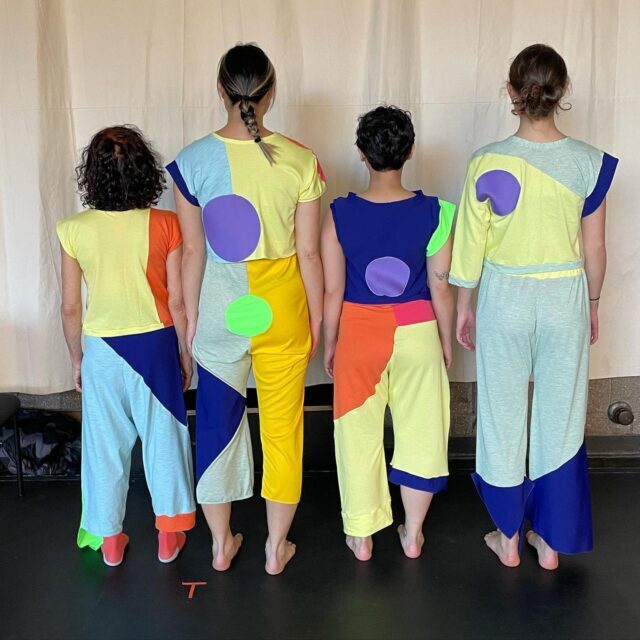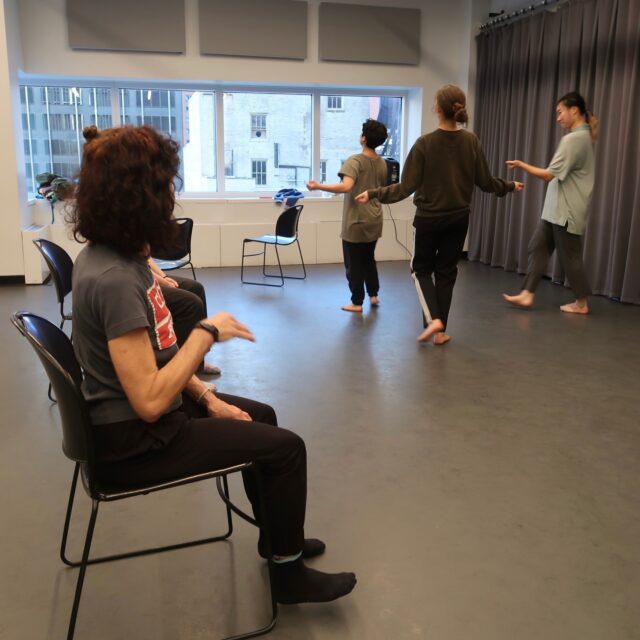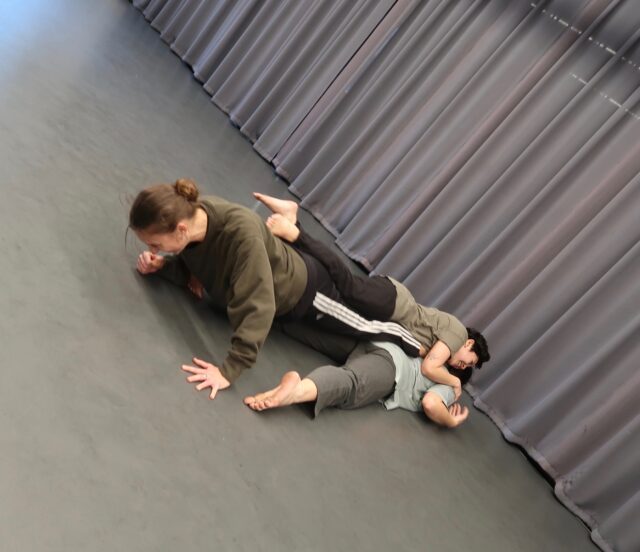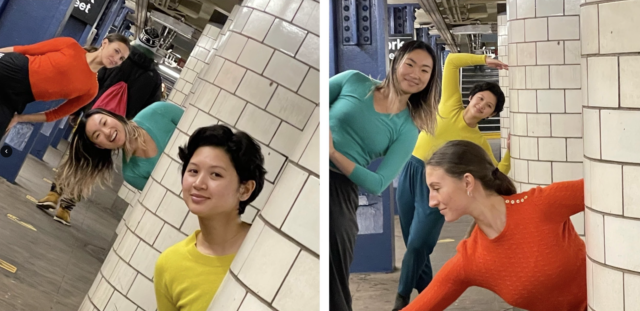
Jody Oberfelder, Grace Yi-Li Tong, Paulina Meneses, and Ashley Merker will perform Rube G. — The Consequence of Action at Gibney this month (costumes by Claire Fleury / photo courtesy Jody Oberfelder Projects)
RUBE G. — THE CONSEQUENCE OF ACTION
Gibney Dance Agnes Varis Performing Arts Center, White Box Studio C
280 Broadway between Chambers & Reade Sts.
Saturday and Sunday, March 4-5, 11-12, 18-19, $15-$25
jodyoberfelder.com
gibneydance.org
New York–based director, dancer, choreographer, and filmmaker Jody Oberfelder is the September 2023 entry in the Modern Women: 21st Century Dance Coloring Book calendar. On that page she says, “Standing on my head I see the world upside down. When I’m right side up, I look again with a different perspective.”
The quote is apropos of her latest piece, Rube G. — The Consequence of Action, making its world premiere March 4-19 at Gibney.
“Many of the younger generation know my name in a vague way and connect it with grotesque inventions but don’t believe that I ever existed as a person,” Rube Goldberg once explained. “They think I am a nonperson, just a name that signifies a tangled web of pipes or wires or strings that suggest machinery. My name to them is like a spiral staircase, veal cutlets, barber’s itch — terms that give you an immediate picture of what they mean.”
Reuben L. Goldberg (1883–1970) was an engineer, sculptor, inventor, author, and cartoonist who won the Pulitzer Prize in 1948 for his political cartoon “Peace Today,” a depiction of an American family and their house perched atop a giant atomic bomb that is tilting precariously at the edge of a cliff. But Goldberg is best known for his drawings of crazy contraptions in which a series of odd items must connect in a chain reaction in order to make something happen, like dominoes but with objects and animals.
In Adam Felber’s 2006 novel Schrödinger’s Ball, a character explains, “You know: a lever is pulled, causing a boot to kick a dog, whose bark motivates a hamster to run on a wheel which winds a pulley that raises a gate that releases a bowling ball and so on? Until, at the end, finally, the machine does something incredibly mundane, like making a piece of toast. Yes? Well, as it turns out, that’s the world.”
A fun, immersive, interactive view of the world and our place in it, Rube G. — The Consequence of Action features Grace Yi-Li Tong, Paulina Meneses, and Ashley Merker, joined by Detroit native Oberfelder, weaving in and around an audience of forty people sitting on stools spaced two feet apart, with music by klezmer trumpeter Frank London. There is light touching as the performers ask audience members to give them small pushes, as if we’re all objects in a Rube Goldberg machine, which the Rube Goldberg Institution for Innovation & Creativity says “solves a simple problem in the most ridiculously inefficient way possible.”
In May 2019, London put together “In Dreams Begin Responsibilities” at the New York Public Library, in which he selected a wide range of artists to pay tribute to such Jewish cultural figures as Hannah Arendt, Benjamin Cardozo, Morton Feldman, Susan Sontag, and Kurt Weill; Oberfelder was assigned Goldberg. She spent the next four years researching him, leading to the short film Rube G., the performance Rube G at Roulette, and Amphitheater in East River Park.
On a recent Monday afternoon, I was a “test guest” at a rehearsal for the new work, experiencing the piece and then talking about it afterward with Oberfelder, Yi-Li Tong, Meneses, Merker, and fellow test guest EmmaGrace Skove as Oberfelder took notes; she was particularly interested in a comment I made about one section reminding me of a pinball machine. Following the discussion, I spoke with Oberfelder — whose oeuvre also includes Madame Ovary, 4Chambers, Throb, The Soldier’s Tale, and The Title Comes Last — about Goldberg, working with new dancers, making connections, and her affinity for site-specific immersive presentations.

Jody Oberfelder watches team rehearse at Open Jar Studios in Midtown (photo by twi-ny/mdr)
twi-ny: In creating this work, did you have a specific fascination with Rube Goldberg himself or the Rube Goldberg machine?
jody oberfelder: I’m thinking of it in a larger context, like how one thing affects another. Frank London actually gave me the assignment in 2019. He had a thing about Jewish thinkers, philosophers, poets, writers. He had like twenty people on a program at the New York Public Library. And he assigned who got what. So I got Rube Goldberg. I knew about Rube Goldberg because when I was working on The Brain Piece, the neuroscientist who was teaching a class in illusion showed us the the Okay Go video [“This Too Shall Pass”], which is quite amazing. I think everybody knows about Rube Goldberg without knowing they know about Rube Goldberg. But now I’ve been researching who he was as a person and how he was of his time. The humor is very much Jewish humor too, like his comic strip “Foolish Questions.” He asks about how things affect each other and that’s a question that’s been in my choreographic toolbox. What interests me is intersections of people and ideas. And my medium is bodies. So this is really nice for me, instead of doing a purely conceptual piece to just work physically with awesome dancers.
twi-ny: You said Frank approached you in 2019, but I would’ve thought that it came out of the pandemic lockdown, when people couldn’t connect. But it was already in process.
j.o.: But that was different; it was more celebratory.
twi-ny: It has the same name, but it’s not the same?
j.o.: That one I called Amphitheater, because I knew I would do Rube G., and then we did the show at Roulette. It totally was about Rube Goldberg.
twi-ny: And you did the film also.
j.o.: The film was a total pandemic film. People said, Look, can’t we wear masks? I’m like, no. Because one day nobody’s going to want to see masks. I look at that film and it was everybody in their little boxes, they would go outside to dance. And I just strung them together with the same words that catalyzed this piece. Like “bounce lever carousel” is one, “slide slice.” So I just came up with the action words from studying Rube Goldberg machines that were posted online, the ones that people work on for a really long time and they jump up and down at the end. In fact, some of the sound score was ripped from YouTube. You can hear the dominoes falling.
twi-ny: So these are new dancers for you?
j.o.: Yes. And that’s what changed the piece.
twi-ny: In what way? Was it an open call?
j.o.: Yes, they’re from the audition that I had. I just thought start fresh, look around, see who’s out there. Ashley is my Gyrotonics teacher; she’s so beautiful when she teaches. I just said, Look, I’m thinking about adding in some new dancers. Do you want to come to the studio? And in a two-hour span of time, I made up a whole bunch of material with her; that was a no-brainer. And then I picked the other two from the audition I had.
twi-ny: Ashley just seems like a natural human connector.
j.o.: She danced with Doug Varone and she still dances with Jacqulyn Buglisi, but I had no idea. You don’t know until you get in the studio how someone will be with you. Each of them has their own quality. They’re not carbon copies of each other. They’re unique dancers. And they just went with the material. I had to stop inventing. Even Frank said, Jody, you’ve got too much material. Just stop inventing.

Grace Yi-Li Tong, Paulina Meneses, and Ashley Merker go horizontal mountain climbing in Rube G. — The Consequence of Action (photo by twi-ny/mdr)
twi-ny: You just want to keep watching them do something.
j.o.: Well, yeah. Now I want to do a pinball machine. I think we’ll have to do something as a transition where someone’s trying to get through and they get bounced back. That’s great.
I don’t like to get an idea from seeing someone in someone else’s piece, because they’ll be different. In fact, I did go see Ashley perform with somebody and I just said, She’ll be different with me.
twi-ny: Since the very beginning of your career, you’ve been into immersive, interactive, site-specific pieces, before it was a thing, a genre. What was the impetus?
j.o.: I’m pretty visual. And I like environments. If I look at the music stands in this room, there’s definite space around each one. [Gets up and walks around room] You get an idea from looking at the place that you’re in. [Returns to seat] The immersive stuff that I’ve been doing the last three years is very much like leading the audience on an experience so that they know what this space is, so that they’re going on a journey.
twi-ny: So that’s how you explore the spaces you’re in? Your mind automatically sees that.
j.o.: I applied for an NEA grant and hopefully we’re going to be partnering with Greenwood Cemetery. That would be the next thing. I came up with a title before, and I have the location. It’s going to be called And then, no.
twi-ny: It’s a great place to see a performance.
j.o.: I’m also doing a piece called Walking to Present, which we’re doing in Munich, right on the site of a Trümmerberg, which is a trauma mountain. It’s at Olympiaberg in Olympic Park. What they did after World War II is they made these huge piles of rubble and just covered it with turf. And then they got the great idea to turn it into a park. And when, when the Olympics came in 1972, they made a beautifully scaled park. And that’s where the performance will take place.
So working on all this primed me to get back to Rube G. in a different way, so that it wouldn’t just be on the stage, there wouldn’t be a separation. It’s an experiment to see if I can be immersive inside, if I can make the room come alive as if it were an installation of people.
twi-ny: Right. As a test guest, that’s exactly what I felt.
j.o.: We’re all in this period where we need to lighten up and not be so hard on ourselves. And we’re in this period where a little goodwill, a little lightheartedness is important. There’s all this heavy stuff we have to think about daily. Walking to Present is a little more deep. But I hope I can find after this piece more lightness, even though the subject matter of walking through history and walking over history is heavy. Cemeteries are heavy, but, on the flip side, you can’t experience heaviness unless you have lightness.
twi-ny: You’re Jewish. Does that have anything to do with your choice of doing it in Munich [where eleven Israeli coaches and athletes were killed in a terrorist attack in the Olympic Village in 1972]?

Jody Oberfelder Projects will become a dancing Rube Goldberg machine in world premiere at Gibney (photo courtesy Jody Oberfelder Projects)
j.o.: Definitely. I’m married to a German guy, so I’ve been going to Germany a lot, and I performed there in 1983, a solo concert in a club, three pieces. And this curator saw me and we’ve been in touch all these years. I was doing my piece Life Traveler with the suitcases, where it’s a one-on-one piece. And she got the gist of that and just said, We’d love you to be part of the [2023 Dance München] festival. So I feel really lucky to have that be in such good company. But Rube G. is its own piece. And it’s not an identity piece. It’s just what it is. It’s not a political statement, but it is kind of, because what would be political about it is what happens when people gather together. Either you resist and you’re destructive or you’re constructive.
twi-ny: Do you see Rube G. as a natural progression of your career or more of an outlier?
j.o.: Oh, well, I see this piece as both. It’s a return to the really athletic physical stuff I did for most of the first twenty years. I mean, I was very athletic. I didn’t dance until I was nineteen and I did gymnastics and water ballet. I was a cheerleader. You couldn’t get me to sit in a chair for over forty minutes.
So it’s a continuation of my exploration of physical possibilities. And it’s fed by the idea that the fourth wall has to come down. It’s just not interesting to me to dance on a stage unless it’s something with bells and whistles, visual opera. I heard a piano concert, Yuja Wang, and that was on a stage and I was riveted, I was part of it. There’s a way to put things on a stage and have the audience be part of it. But I like intimacy.
twi-ny: As an audience member at so many of your shows, I can say that’s one of the draws; you’re not going to just be sitting in the audience as an observer. You’re going to be involved. You might be physically touched, but you’ll certainly be emotionally and psychologically touched.
j.o.: Well, with these pieces that only forty people can attend, it’s hard to make a living. I have to do a benefit and hope people will come to that [on March 19]. Apply for grants . . . but I’m not complaining. I don’t stop working. I feel like dancers and artists, we work so hard, and our brilliance is something the world needs. The climate is making the world smaller. We’re all going to be suffering the same things. I hope I’m putting something really great in the world for people to experience.